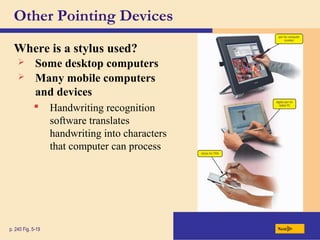
Ch 5
- 1. Other Pointing Devices Where is a stylus used? p. 240 Fig. 5-19 Next Some desktop computers Many mobile computers and devices Handwriting recognition software translates handwriting into characters that computer can process
- 2. Voice Input How does voice recognition work? p. 242 Fig. 5-20 Next Step 2. An analog-to-digital converter (ADC) translates sound waves into digital measurements computer can process. Measurements include pitch, volume, silences, and phonemes. Phonemes are sound units such as aw and guh. 10010111010110101100001101 Step 3. Software compares spoken measurements with those in its database to find a match or list of possible matches. Matches Step 4. To narrow a list down, software presents user with a list of choices or uses a natural language component to predict most likely match. User may correct any selection made by software. Natural Language Engine Click to view Web Link, click Chapter 5, Click Web Link from left navigation, then click Voice Input below Chapter 5 Step 1. A user dictates text into a microphone.
- 3. Digital Cameras What is a digital camera? p. 247 Fig. 5-26 Next Allows you to take digital pictures Images viewable immediately on camera Download to computer Post pictures to Web
- 4. Digital Cameras How does a digital camera work? p. 248 Fig. 5-27 Next Step 1. Point to the image to photograph and take picture. Light passes into the lens of the camera. Step 2. Image is focused on a chip called a charge-coupled device (CCD). Step 3. CCD generates an analog signal that represents the image. Step 4. Analog signal is converted to digital signal by analog-to- digital converter (ADC). Step 5. Digital signal processor (DSP) adjusts quality of image and usually stores digital image on miniature mobile storage media in the camera. Step 6. Images are transferred to a computer’s hard disk by plugging one end of the cable into a camera and the other end into a computer; or images are copied to hard disk from storage media used in the camera. Step 7. Using software supplied with the camera, images are viewed on screen, incorporated into documents, edited, and printed.
- 5. Digital Cameras What is resolution? p. 249 Fig. 5-28 Next Sharpness and clarity of image The higher the resolution, the better the image quality, but the more expensive the camera Pixel (picture element) is single point in electronic image Greater the number of pixels, the better the image quality
- 6. Video Input What is video input? p. 250 Fig. 5-29 Next Process of entering full-motion images into computer Video capture card is adapter card that converts analog video signal into digital signal that computer can use Digital video (DV) camera records video as digital signals
- 7. Video Input What are a PC video camera and a Web cam? p. 250 Fig. 5-30 Next PC video camerac—cDV camera used to capture video and still images, and to make video telephone calls on Internet Also called PC camera Web camc—cvideo camera whose output displays on a Web page Click to view video Click to view Web Link, click Chapter 5, Click Web Link from left navigation, then click PC Video Cameras below Chapter 5
- 8. Video Input What is video conferencing? p. 251 Fig. 5-31 Next Whiteboard is another window on screen that can display notes and drawings simultaneously on all participants’ screens Two or more geographically separated people who use network on Internet to transmit audio and video data
- 9. Scanners and Reading Devices What is a scanner? p. 252 Fig. 5-32 Next Flatbed Pen or Handheld Sheet-fed Drum Light-sensing device that reads printed text and graphics Used for image processing, converting paper documents into electronic images Click to view animation Click to view Web Link, click Chapter 5, Click Web Link from left navigation, then click Scanner below Chapter 5
- 10. Scanners and Reading Devices How does a flatbed scanner work? p. 253 Fig. 5-33 Next Step 2. Bright light moves underneath scanned document. Step 3. Image of the document is reflected into a series of mirrors. Step 1. Document to be scanned is placed face down on the glass window. Step 6. Users can print image, e-mail it, include it in a document, or place it on a Web page. Step 4. Light is converted to analog electrical current that is converted to digital signal by an analog-to-digital converter (ADC). Step 5. Digital information is sent to memory in the computer to be used by illustration, desktop publishing, or other software; or it is stored on disk.
- 11. Scanners and Reading Devices What is an optical reader? p. 254 Fig. 5-34 Next Optical character recognition (OCR) reads characters in OCR font Optical mark recognition (OMR) reads hand-drawn pencil marks, such as small circles Bar code scanner Device that uses light source to read characters, marks, and codes and then converts them into digital data
- 12. Scanners and Reading Devices What is a bar code reader? p. 255 Fig. 5-36 Next Uses laser beams to read bar codes
- 13. Scanners and Reading Devices What is a bar code? p. 255 Fig. 5-37 Next Identification code that consists of a set of vertical lines and spaces of different widths Universal Product Code (UPC)
- 14. Scanners and Reading Devices What are some widely used bar codes? p. 256 Fig. 5-38 Next
- 15. What is a magnetic-ink character recognition (MICR) reader? Scanners and Reading Devices p. 257 Fig. 5-39 Next Can read text printed with magnetized ink Banking industry almost exclusively uses MICR for check processing
- 16. Biometric Input What is biometrics? p. 260 Fig. 5-45 Next Authenticates person’s identity by verifying personal characteristic Fingerprint scanner captures curves and indentations of fingerprint Hand geometry system measures shape and size of person’s hand Click to view video Click to view Web Link, click Chapter 5, Click Web Link from left navigation, then click Biometric Input below Chapter 5
